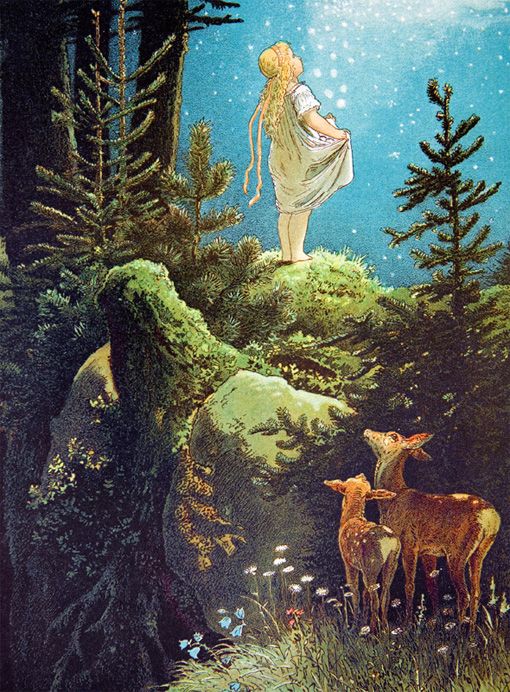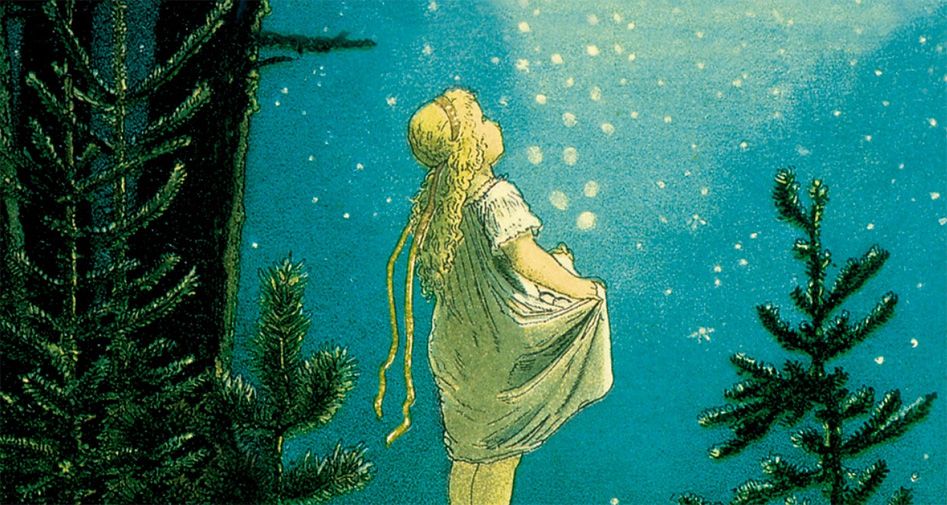Reading time: 4 min
There was once on a time a little girl whose father and mother were dead, and she was so poor that she no longer had any little room to live in, or bed to sleep in, and at last she had nothing else but the clothes she was wearing and a little bit of bread in her hand which some charitable soul had given her. She was, however, good and pious. And as she was thus forsaken by all the world, she went forth into the open country, trusting in the good God.
Then a poor man met her, who said: „Ah, give me something to eat, I am so hungry!“ She reached him the whole of her piece of bread, and said: „May God bless it to thy use,“ and went onwards. Then came a child who moaned and said: „My head is so cold, give me something to cover it with.“ So she took off her hood and gave it to him; and when she had walked a little farther, she met another child who had no jacket and was frozen with cold. Then she gave it her own; and a little farther on one begged for a frock, and she gave away that also. At length she got into a forest and it had already become dark, and there came yet another child, and asked for a little shirt, and the good little girl thought to herself: „It is a dark night and no one sees thee, thou canst very well give thy little shirt away,“ and took it off, and gave away that also.

And as she so stood, and had not one single thing left, suddenly some stars from heaven fell down, and they were nothing else but hard smooth pieces of money, and although she had just given her little shirt away, she had a new one which was of the very finest linen. Then she gathered together the money into this, and was rich all the days of her life.
 Learn languages. Double-tap on a word.Learn languages in context with Childstories.org and Deepl.com.
Learn languages. Double-tap on a word.Learn languages in context with Childstories.org and Deepl.com.Backgrounds
Interpretations
Adaptions
Summary
Linguistics
„The Star Money“ is a German fairy tale, also known as „Die Sterntaler“ in its original German title. It is part of the collection of folktales compiled by the Brothers Grimm, Jacob and Wilhelm, during the early 19th century. The Brothers Grimm were German academics, linguists, cultural researchers, and authors who collected and published folklore as part of their efforts to preserve and document the rich oral storytelling tradition in Germany.
The first edition of their famous collection, „Kinder- und Hausmärchen“ (Children’s and Household Tales), was published in 1812. It contained 86 stories, with subsequent editions expanding the collection to over 200 tales. „The Star Money“ is included in this collection, and it is categorized as tale number 153 in the final edition published during the Grimm brothers‘ lifetime.
The Brothers Grimm’s collection of fairy tales is considered a cornerstone of Western literature and has been translated into numerous languages. Their work has had a significant impact on the study of folklore and the development of the modern fairy tale genre. Many of the stories, including „The Star Money,“ have been adapted into various forms of media such as film, television, and theater, and they continue to be cherished and enjoyed by readers of all ages worldwide.
„The Star Money“ can be interpreted in various ways, offering valuable life lessons and morals:
The power of kindness and generosity: The girl’s selfless acts of giving away everything she has, even when she herself is in need, demonstrate the importance of helping others. Her kindness is rewarded, emphasizing the idea that good deeds are often repaid in unexpected ways.
The virtue of faith: The girl’s unwavering faith in God, despite her difficult circumstances, highlights the power of belief and trust in a higher power. This faith guides her actions and ultimately leads to her reward.
The importance of humility: The girl does not hesitate to give away her last possessions, including her clothes, highlighting the value of humility and putting others‘ needs before one’s own.
The idea of divine intervention: The miraculous event of stars turning into money and the appearance of a new shirt suggest divine intervention as a reward for the girl’s virtuous actions. This interpretation emphasizes the belief that God watches over and rewards those who are kind, generous, and faithful.
The concept of inner wealth: The girl’s generosity and kindness demonstrate that true wealth lies within one’s character and actions, rather than material possessions. Her selflessness and compassion make her rich in spirit, which is eventually reflected in her newfound material wealth.
Overall, „The Star Money“ offers a heartwarming and inspiring message about the importance of kindness, generosity, faith, and humility in the face of adversity.
„The Star Money“ is a classic fairy tale that has been adapted and reimagined in various forms across different media. Here are a few examples of adaptations.
Picture Books: There are numerous picture book adaptations of „The Star Money,“ aimed at young children. These books often feature bright, colorful illustrations that bring the story to life.
Animated Films: „The Star Money“ has been adapted into several animated films, including the 1990s Russian animated film „Zvezdniye Moneti“ and the 2019 American short film „The Star Money.“
Stage Productions: The story has also been adapted for the stage, with several theater companies producing their own versions of the tale. Some of these productions incorporate music and dance to create a more immersive experience for audiences.
Literary Retellings: Many writers have reimagined „The Star Money“ in their own ways, incorporating new characters and plot elements. For example, Donna Jo Napoli’s 1996 book „The Magic Circle“ features a retelling of the story set in medieval Europe.
Modern Adaptations: „The Star Money“ has also been adapted for modern audiences, with updated settings and themes. For example, the 2001 film „The Shipping News“ features a character who gives away his lottery winnings to help others, echoing the themes of generosity and selflessness in the original tale.
Overall, „The Star Money“ has proven to be a timeless and adaptable story that continues to inspire new creative works across different media.
„The Star Money“ is a fairy tale by Brothers Grimm about a little girl who is orphaned and left with nothing but the clothes on her back and a piece of bread. Despite her misfortune, she is kind and pious, and she sets out into the open country, trusting in God.
During her journey, she encounters several people in need. She meets a hungry man and gives him her bread, followed by a child who needs a head covering, to whom she gives her hood. As she continues, she encounters more children needing clothes, and she gives away her jacket, frock, and finally, her little shirt.
Now completely without possessions, the girl finds herself alone in a dark forest. Suddenly, stars fall from the sky, transforming into smooth pieces of money. Miraculously, she also finds herself wearing a new shirt made of the finest linen. She gathers the money and becomes wealthy, living a prosperous life for the rest of her days.
The story emphasizes the virtues of kindness, selflessness, and faith, as the girl’s generosity is ultimately rewarded with wealth and security.
The fairy tale „The Star Money“ by the Brothers Grimm presents a simple yet profound narrative, rich with themes and linguistic features that reflect the moral and cultural values of its time. Let’s explore some key aspects of its linguistic and thematic composition:
Themes and Morals
Selflessness and Generosity: The protagonist is depicted as a model of selflessness. Despite her own destitution, she gives away all she has, including her clothes, to those in need. This theme underscores the moral lesson that true wealth comes from generosity and kindness.
Divine Providence and Faith: The girl’s unwavering faith in divine providence is central to the story. Her trust in „the good God“ suggests a moral universe where good deeds are ultimately rewarded, aligning with Christian values prevalent during the Brothers Grimm’s era.
Transformation and Reward: The culmination of the story, where stars transform into money, serves as a metaphorical reward for the girl’s virtue. It highlights the transformative power of good deeds and the idea that moral actions yield rewards.
Simple and Direct Language: The language used is straightforward and accessible, a characteristic feature of many fairy tales intended for children. The simplicity aids in conveying the story’s moral clearly and effectively.
Repetition and Parallel Structure: The tale employs repetition, especially in structure, as the girl repeatedly encounters individuals in need and responds with generosity. This repetition reinforces the theme and builds anticipation for the narrative’s resolution.
Use of Dialogue: Dialogue is sparingly used but is impactful, serving to directly present the needs of each person the girl meets and her generous responses. This minimal dialogue shifts focus to the actions of the protagonist, emphasizing the moral message.
Imagery and Symbolism: Imagery is vivid yet concise, such as “stars from heaven fell down” and “the very finest linen,” encapsulating transformation and abundance. The stars are potent symbols of hope, purity, and celestial reward.
Narrative Tone: The tone is gentle and compassionate, aligning with the story’s moral lessons. It creates a sense of warmth and admiration for the protagonist’s character, guiding readers to empathize with and aspire to her virtues.
Cultural and Historical Context
– The tale reflects 19th-century European values, especially those regarding Christian morality and the belief in divine justice. During the Brothers Grimm’s time, fairy tales often functioned as didactic tools, teaching children moral lessons through simple, engaging narratives. The socioeconomic context is hinted at, with widespread poverty and the reliance on charity depicted in the girl’s interactions, providing a realistic backdrop that enhances the story’s moral weight.
In summary, „The Star Money“ uses straightforward language and powerful symbolism to convey timeless themes of generosity, faith, and moral recompense, reflecting the Brothers Grimm’s intent to impart moral lessons through engaging storytelling.
Information for scientific analysis
Fairy tale statistics | Value |
|---|---|
| Number | KHM 153 |
| Aarne-Thompson-Uther-Index | ATU Typ 779 |
| Translations | DE, EN, DA, ES, FR, PT, FI, HU, IT, JA, NL, PL, RO, RU, TR, VI, ZH |
| Readability Index by Björnsson | 37.8 |
| Flesch-Reading-Ease Index | 72.1 |
| Flesch–Kincaid Grade-Level | 10.8 |
| Gunning Fog Index | 13.4 |
| Coleman–Liau Index | 6.4 |
| SMOG Index | 8.7 |
| Automated Readability Index | 11.7 |
| Character Count | 1.668 |
| Letter Count | 1.272 |
| Sentence Count | 11 |
| Word Count | 337 |
| Average Words per Sentence | 30,64 |
| Words with more than 6 letters | 24 |
| Percentage of long words | 7.1% |
| Number of Syllables | 413 |
| Average Syllables per Word | 1,23 |
| Words with three Syllables | 10 |
| Percentage Words with three Syllables | 3% |

 Facebook
Facebook  Whatsapp
Whatsapp  Messenger
Messenger  Telegram
Telegram Reddit
Reddit













